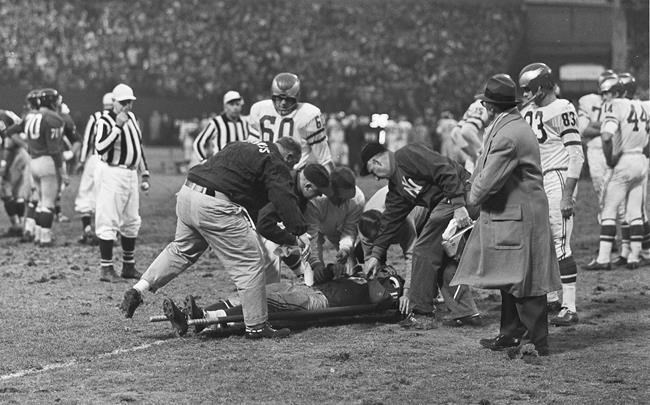
FILE - In this Nov. 20, 1960, file photo, Chuck Bednarik (60) of the Philadelphia Eagles looks on as Frank Gifford of the New York Giants is put on a stretcher in the last quarter of a football game at Yankee Stadium in New York. The Eagles' Bobby Walston (83) is at right. Gifford was carried off the field unconscious and rushed to a hospital where he was reported to have a severe concussion. The family of Pro Football Hall of Famer Frank Gifford says signs of the degenerative disease chronic traumatic encephalopathy were found in his brain after his death. In a statement released through NBC News on Wednesday, Nov. 25, 2015, the family says Gifford suffered from unspecified “cognitive and behavioral symptoms” in his later years. He died suddenly of natural causes at his Connecticut home in August at age 84.
Image Credit: (AP Photo/Harry Harris, File)
November 25, 2015 - 5:30 PM
NEW YORK, N.Y. - The family of Pro Football Hall of Famer Frank Gifford says signs of the degenerative disease chronic traumatic encephalopathy were found in his brain after his death.
In a statement released through NBC News on Wednesday, the family said he had "experienced firsthand" symptoms associated with CTE but did not offer specifics. Gifford died of natural causes at his Connecticut home in August at age 84.
His widow, Kathie Lee Gifford, is a host for NBC's "Today."
The statement said that the family "made the difficult decision to have his brain studied in hopes of contributing to the advancement of medical research concerning the link between football and traumatic brain injury."
"Our suspicions that he was suffering from the debilitating effects of head trauma were confirmed," the Giffords added.
CTE, which can be diagnosed only after death, has been found in the brains of dozens of former players. Linked to repeated brain trauma, it is associated with symptoms such as memory loss, impaired judgment, depression, and, eventually, progressive dementia.
The statement said the family found "comfort in knowing that by disclosing his condition we might contribute positively to the ongoing conversation that needs to be had; that he might be an inspiration for others suffering with this disease that needs to be addressed in the present; and that we might be a small part of the solution to an urgent problem concerning anyone involved with football, at any level."
A running back, defensive back, wide receiver and special teams player, Gifford was the NFL MVP in 1956 when his New York Giants won the league championship. A crushing hit by Eagles linebacker Chuck Bednarik in November 1960 flattened Gifford and likely shortened his football career. Bednarik was pictured standing over the unconscious Gifford, pumping his fist in celebration. Gifford was in the hospital for 10 days and sidelined until 1962.
"We have great respect and sympathy for the Gifford family," the Giants said in a statement. "We all miss Frank dearly. We support the family's decision to contribute to the discussion and research of an issue we take very seriously."
NFL Commissioner Roger Goodell called Gifford "a beloved member of the NFL family."
"He exemplified everything good about our game throughout his ...m years of extraordinary accomplishments, both on and off the field," Goodell said in a statement Wednesday night. "We appreciate the Gifford family's desire to help the medical community understand more about CTE, and we are grateful for their support of the league's efforts to improve safety in our game. At the NFL, we are supporting grants to NIH and Boston University as well as other independent efforts to research the effects of repetitive head trauma.
"But we are not waiting until science provides all of the answers. We are working now to improve the safety of our game. The NFL has made numerous rules changes to the game, all to enhance player health and safety at all levels of football. These include 39 rule changes and better training and practice protocols that are yielding measurable results.
"This work will continue as the health and safety of our players remains our highest priority. We have more work to do — work that honours great men like Frank Gifford."
Gifford later had a successful second career in broadcasting, most notably on ABC's "Monday Night Football," where he famously served as a buffer between fellow announcers Don Meredith and Howard Cosell.
News from © Associated Press, 2015